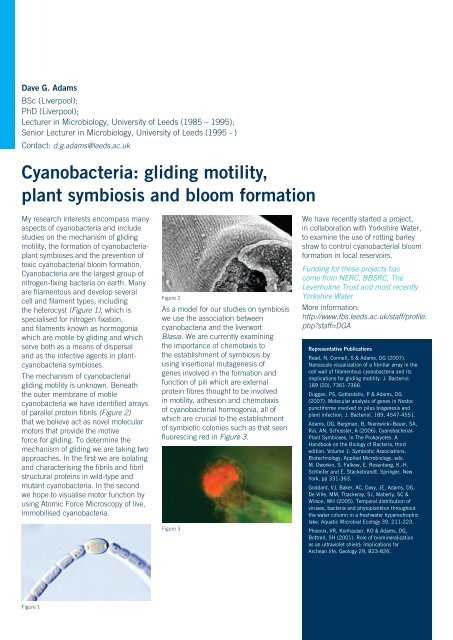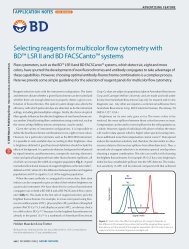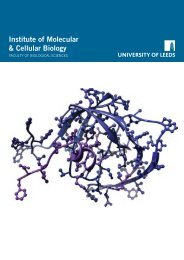3649-08 IICB.indd - Faculty of Biological Sciences - University of ...
3649-08 IICB.indd - Faculty of Biological Sciences - University of ...
3649-08 IICB.indd - Faculty of Biological Sciences - University of ...
Create successful ePaper yourself
Turn your PDF publications into a flip-book with our unique Google optimized e-Paper software.
Dave G. Adams<br />
BSc (Liverpool);<br />
PhD (Liverpool);<br />
Lecturer in Microbiology, <strong>University</strong> <strong>of</strong> Leeds (1985 – 1995);<br />
Senior Lecturer in Microbiology, <strong>University</strong> <strong>of</strong> Leeds (1995 - )<br />
Contact: d.g.adams@leeds.ac.uk<br />
Cyanobacteria: gliding motility,<br />
plant symbiosis and bloom formation<br />
My research interests encompass many<br />
aspects <strong>of</strong> cyanobacteria and include<br />
studies on the mechanism <strong>of</strong> gliding<br />
motility, the formation <strong>of</strong> cyanobacteriaplant<br />
symbioses and the prevention <strong>of</strong><br />
toxic cyanobacterial bloom formation.<br />
Cyanobacteria are the largest group <strong>of</strong><br />
nitrogen-fixing bacteria on earth. Many<br />
are filamentous and develop several<br />
cell and filament types, including<br />
the heterocyst (Figure 1), which is<br />
specialised for nitrogen fixation,<br />
and filaments known as hormogonia<br />
which are motile by gliding and which<br />
serve both as a means <strong>of</strong> dispersal<br />
and as the infective agents in plantcyanobacteria<br />
symbioses.<br />
The mechanism <strong>of</strong> cyanobacterial<br />
gliding motility is unknown. Beneath<br />
the outer membrane <strong>of</strong> motile<br />
cyanobacteria we have identified arrays<br />
<strong>of</strong> parallel protein fibrils (Figure 2)<br />
that we believe act as novel molecular<br />
motors that provide the motive<br />
force for gliding. To determine the<br />
mechanism <strong>of</strong> gliding we are taking two<br />
approaches. In the first we are isolating<br />
and characterising the fibrils and fibril<br />
structural proteins in wild-type and<br />
mutant cyanobacteria. In the second<br />
we hope to visualise motor function by<br />
using Atomic Force Microscopy <strong>of</strong> live,<br />
immobilised cyanobacteria.<br />
Figure 2<br />
As a model for our studies on symbiosis<br />
we use the association between<br />
cyanobacteria and the liverwort<br />
Blasia. We are currently examining<br />
the importance <strong>of</strong> chemotaxis to<br />
the establishment <strong>of</strong> symbiosis by<br />
using insertional mutagenesis <strong>of</strong><br />
genes involved in the formation and<br />
function <strong>of</strong> pili which are external<br />
protein fibres thought to be involved<br />
in motility, adhesion and chemotaxis<br />
<strong>of</strong> cyanobacterial hormogonia, all <strong>of</strong><br />
which are crucial to the establishment<br />
<strong>of</strong> symbiotic colonies such as that seen<br />
fluorescing red in Figure 3.<br />
Figure 3<br />
We have recently started a project,<br />
in collaboration with Yorkshire Water,<br />
to examine the use <strong>of</strong> rotting barley<br />
straw to control cyanobacterial bloom<br />
formation in local reservoirs.<br />
Funding for these projects has<br />
come from NERC, BBSRC, The<br />
Leverhulme Trust and most recently<br />
Yorkshire Water.<br />
More information:<br />
http://www.fbs.leeds.ac.uk/staff/pr<strong>of</strong>ile.<br />
php?staff=DGA<br />
Representative Publications<br />
Read, N, Connell, S & Adams, DG (2007).<br />
Nanoscale visualization <strong>of</strong> a fibrillar array in the<br />
cell wall <strong>of</strong> filamentous cyanobacteria and its<br />
implications for gliding motility. J. Bacteriol.<br />
189 (20), 7361-7366.<br />
Duggan, PS, Gottardello, P & Adams, DG<br />
(2007). Molecular analysis <strong>of</strong> genes in Nostoc<br />
punctiforme involved in pilus biogenesis and<br />
plant infection. J. Bacteriol. 189, 4547-4551.<br />
Adams, DG, Bergman, B, Nierzwicki-Bauer, SA,<br />
Rai, AN, Schussler, A (2006). Cyanobacterial-<br />
Plant Symbioses, in The Prokaryotes. A<br />
Handbook on the Biology <strong>of</strong> Bacteria, third<br />
edition. Volume 1: Symbiotic Associations,<br />
Biotechnology, Applied Microbiology, eds.<br />
M. Dworkin, S. Falkow, E. Rosenberg, K.-H.<br />
Schleifer and E. Stackebrandt. Springer, New<br />
York, pp 331-363.<br />
Goddard, VJ, Baker, AC, Davy, JE, Adams, DG,<br />
De Ville, MM, Thackeray, SJ, Maberly, SC &<br />
Wilson, WH (2005). Temporal distribution <strong>of</strong><br />
viruses, bacteria and phytoplankton throughout<br />
the water column in a freshwater hypereutrophic<br />
lake. Aquatic Microbial Ecology 39, 211-223.<br />
Phoenix, VR, Konhauser, KO & Adams, DG,<br />
Bottrell, SH (2001). Role <strong>of</strong> biomineralization<br />
as an ultraviolet shield: Implications for<br />
Archean life. Geology 29, 823-826.<br />
Figure 1










